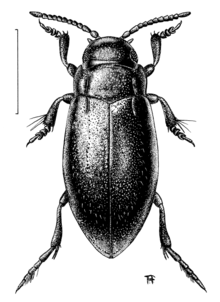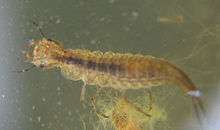Dytiscidae
| Dytiscidae | |
|---|---|
 | |
| Liodessus plicatus | |
| Scientific classification | |
| Kingdom: | Animalia |
| Clade: | Euarthropoda |
| Class: | Insecta |
| Order: | Coleoptera |
| Superfamily: | Dytiscoidea |
| Family: | Dytiscidae Leach, 1815 |
_-_(imago)%2C_Berkenwoude%2C_the_Netherlands.jpg)
The Dytiscidae – based on the Greek dytikos (δυτικός), "able to dive" – are the predaceous diving beetles, a family of water beetles. They occur in virtually any freshwater habitat around the world, but a few species live among leaf litter.[1] The adults of most are between 1 and 2.5 cm (0.4–1.0 in) long, though much variation is seen between species. The European Dytiscus latissimus and Brazilian Megadytes ducalis are the largest, reaching up to 4.5 cm (1.8 in) and 4.75 cm (1.9 in) respectively.[1][2] In contrast, the smallest is likely the Australian Limbodessus atypicali of subterranean waters, which only is about 0.9 mm (0.035 in) long.[1] Most are dark brown, blackish, or dark olive in color with golden highlights in some subfamilies. They have short, but sharp mandibles. Immediately upon biting, they deliver digestive enzymes. The larvae are commonly known as water tigers.[3] The family includes more than 4,000 described species in numerous genera.[4]
Larvae and development

When still in larval form, the beetles vary in size from about 1 to 5 cm (0.5 to 2.0 in). The larval bodies are shaped like crescents, with the tail long and covered with thin hairs. Six legs protrude from along the thorax, which also sports the same thin hairs. The head is flat and square, with a pair of long, large pincers. When hunting, they cling to grasses or pieces of wood along the bottom, and hold perfectly still until prey passes by, then they lunge, trapping their prey between their front legs and biting down with their pincers. Their usual prey includes tadpoles and glassworms, among other smaller water-dwelling creatures.
As the larvae mature, they crawl from the water on the sturdy legs, and bury themselves in the mud for pupation. After about a week, or longer in some species, they emerge from the mud as adults.
Edibility
Adult Dytiscidae, particular of the genus Cybister, are edible. Remnants of C. explanatus were found in prehistoric human coprolites in a Nevada cave, likely sourced from the Humboldt Sink.[5] In Mexico, C. explanatus is eaten roasted and salted to accompany tacos. In Japan, C. japonicus has been used as food in certain regions such as Nagano prefecture. In the Guangdong Province of China, the latter species, as well as C. bengalensis, C. guerini, C. limbatus, C. sugillatus, C. tripunctatus, and probably also the well-known Great diving beetle (D. marginalis) are bred for human consumption, though as they are cumbersome to raise due to their carnivorous habit and have a fairly bland (though apparently not offensive) taste and little meat, this is decreasing. Dytiscidae are reportedly also eaten in Taiwan, Thailand, and New Guinea.[6]

Large but slow on land and not particularly fierce as adults, they are also eaten with relish by many midsized birds, mammals, and other larger predators. The larvae are usually safer, due to their camouflage and ability to escape by water jet; they can be quite hard to catch and may become apex predators in small ponds.
Cultural significance
The diving beetle plays a role in a Cherokee creation story. According to the narrative, upon finding nowhere to rest in the "liquid chaos" the beetle brought up soft mud from the bottom. This mud then spread out to form all of the land on Earth.[5]
Ethnobiology
Adult Dytiscidae, as well as Gyrinidae, are collected by young girls in East Africa. It is believed that inducing the beetles to bite the nipples will stimulate breast growth.[5]
Systematics
The following taxonomic sequence gives the subfamilies, their associated genera.[7]
Subfamily Agabinae Thomson, 1867
- Agabus Leach, 1817
- Agametrus Sharp, 1882
- Andonectes Guéorguiev, 1971
- Hydronebrius Jakovlev, 1897
- Hydrotrupes Sharp, 1882
- Ilybiosoma Crotch, 1873
- Ilybius Erichson, 1832
- Leuronectes Sharp, 1882
- Platambus Thomson, 1859
- Platynectes Régimbart, 1879
Subfamily Colymbetinae Erichson, 1837
- Anisomeria Brinck, 1943
- Senilites Brinck, 1948
- Carabdytes Balke, Hendrich & Wewalka, 1992
- Bunites Spangler, 1972
- Colymbetes Clairville, 1806
- Hoperius Fall, 1927
- Meladema Laporte, 1835
- Melanodytes Seidlitz, 1887
- Neoscutopterus J.Balfour-Browne, 1943
- Rhantus Dejean, 1833
- Rugosus García, 2001
Subfamily Copelatinae Branden, 1885
- Agaporomorphus Zimmermann, 1921
- Aglymbus Sharp, 1882
- Capelatus Turner & Bilton, 2015
- Copelatus Erichson, 1832
- Lacconectus Motschulsky, 1855
- Liopterus Dejean, 1833
- Papuadytes Balke, 1998
Subfamily Coptotominae Branden, 1885
- Coptotomus Say, 1830
Subfamily Dytiscinae Leach, 1815
- Acilius Leach, 1817
- Aethionectes Sharp, 1882
- Austrodytes Watts, 1978
- Cybister Curtis, 1827
- Dytiscus Linnaeus, 1758
- Eretes Laporte, 1833
- Graphoderus Dejean, 1833
- Hydaticus Leach, 1817
- Hyderodes Hope, 1838
- Megadytes Sharp, 1882
- Miodytiscus Wickham, 1911
- Notaticus Zimmermann, 1928
- Onychohydrus Schaum & White, 1847
- Prodaticus Sharp, 1882
- Regimbartina Chatanay, 1911
- Rhantaticus Sharp, 1882
- Sandracottus Sharp, 1882
- Spencerhydrus Sharp, 1882
- Sternhydrus Brinck, 1945
- Thermonectus Dejean, 1833
- Tikoloshanes Omer-Cooper, 1956
Subfamily Hydrodytinae K.B.Miller, 2001
- Hydrodytes K.B.Miller, 2001
- Microhydrodytes K.B.Miller, 2002
Subfamily Hydroporinae Aubé, 1836
- Africodytes Biström, 1988
- Agnoshydrus Biström, Nilsson & Wewalka, 1997
- Allodessus Guignot, 1953
- Allopachria Zimmermann, 1924
- Amarodytes Régimbart, 1900
- Andex Sharp, 1882
- Anginopachria Wewalka, Balke & Hendrich, 2001
- Anodocheilus Babington, 1841
- Antiporus Sharp, 1882
- Barretthydrus Lea, 1927
- Bidessodes Régimbart, 1900
- Bidessonotus Régimbart, 1895
- Bidessus Sharp, 1882
- Borneodessus Balke, Hendrich, Mazzoldi & Biström, 2002
- Brachyvatus Zimmermann, 1919
- Calicovatellus K.B.Miller & Lubkin, 2001
- Canthyporus Zimmermann, 1919
- Carabhydrus Watts, 1978
- Celina Aubé, 1837
- Chostonectes Sharp, 1882
- Clypeodytes Régimbart, 1894
- Coelhydrus Sharp, 1882
- Comaldessus Spangler & Barr, 1995
- Crinodessus K.B.Miller, 1997
- Darwinhydrus Sharp, 1882
- Deronectes Sharp, 1882
- Derovatellus Sharp, 1882
- Desmopachria Babington, 1841
- Dimitshydrus Uéno, 1996
- Geodessus Brancucci, 1979
- Gibbidessus Watts, 1978
- Glareadessus Wewalka & Biström, 1998
- Graptodytes Seidlitz, 1887
- Haideoporus Young & Longley, 1976
- Hemibidessus Zimmermann, 1921
- Heroceras Guignot, 1950
- Herophydrus Sharp, 1882
- Heterhydrus Fairmaire, 1869
- Heterosternuta Strand, 1935
- Hovahydrus Biström, 1982
- Huxelhydrus Sharp, 1882
- Hydrocolus Roughley & Larson, 2000
- Hydrodessus J.Balfour-Browne, 1953
- Hydroglyphus Motschulsky, 1853
- Hydropeplus Sharp, 1882
- Hydroporus Clairville, 1806
- Hydrovatus Motschulsky, 1853
- Hygrotus Stephens, 1828
- Hyphoporus Sharp, 1882
- Hyphovatus Wewalka & Biström, 1994
- Hyphydrus Illiger, 1802
- Hypodessus Guignot, 1939
- Iberoporus Castro & Delgado, 2001
- Kintingka Watts & Humphreys, 1999
- Kuschelydrus Ordish, 1976
- Laccornellus Roughley & Wolfe, 1987
- Laccornis Gozis, 1914
- Leiodytes Guignot, 1936
- Limbodessus Guignot, 1939
- Liodessus Guignot, 1939
- Lioporeus Guignot, 1950
- Megaporus Brinck, 1943
- Metaporus Guignot, 1945
- Methles Sharp, 1882
- Microdessus Young, 1967
- Microdytes J.Balfour-Browne, 1946
- Morimotoa Uéno, 1957
- Nebrioporus Régimbart, 1906
- Necterosoma W.J. Macleay, 1871
- Neobidessus Young, 1967
- Neoclypeodytes Young, 1967
- Neoporus Guignot, 1931
- Nirripirti Watts & Humphreys, 2001
- Oreodytes Seidlitz, 1887
- Pachydrus Sharp, 1882
- Pachynectes Régimbart, 1903
- Papuadessus Balke, 2001
- Paroster Sharp, 1882
- Peschetius Guignot, 1942
- Phreatodessus Ordish, 1976
- Platydytes Biström, 1988
- Porhydrus Guignot, 1945
- Primospes Sharp, 1882
- Procoelambus Théobald, 1937
- Pseuduvarus Biström, 1988
- Pteroporus Guignot, 1933
- Queda Sharp, 1882
- Rhithrodytes Bameul, 1989
- Sanfilippodytes Franciscolo, 1979
- Scarodytes Gozis, 1914
- Schistomerus Palmer, 1957
- Sekaliporus Watts, 1997
- Sharphydrus Omer-Cooper, 1958
- Siamoporus Spangler, 1996
- Siettitia Abeille de Perrin, 1904
- Sinodytes Spangler, 1996
- Sternopriscus Sharp, 1882
- Stictonectes Brinck, 1943
- Stictotarsus Zimmermann, 1919
- Stygoporus Larson & LaBonte, 1994
- Suphrodytes Gozis, 1914
- Tepuidessus Spangler, 1981
- Terradessus Watts, 1982
- Tiporus Watts, 1985
- Trichonectes Guignot, 1941
- Trogloguignotus Sanfilippo, 1958
- Tyndallhydrus Sharp, 1882
- Typhlodessus Brancucci, 1985
- Uvarus Guignot, 1939
- Vatellus Aubé, 1837
- Yola Gozis, 1886
- Yolina Guignot, 1936
Subfamily Laccophilinae Gistel, 1856
- Agabetes Crotch, 1873
- Africophilus Guignot, 1948
- Australphilus Watts, 1978
- Japanolaccophilus Satô, 1972
- Laccodytes Régimbart, 1895
- Laccophilus Leach, 1815
- Laccoporus J.Balfour-Browne, 1939
- Laccosternus Brancucci, 1983
- Napodytes Steiner, 1981
- Neptosternus Sharp, 1882
- Philaccolilus Guignot, 1937
- Philaccolus Guignot, 1937
- Philodytes J.Balfour-Browne, 1939
Subfamily Lancetinae Branden, 1885
- Lancetes Sharp, 1882
Subfamily Matinae Branden, 1885
- Allomatus Mouchamps, 1964
- Batrachomatus Clark, 1863
- Matus Aubé, 1836
Subfamily Incertae sedis
- Cretodytes Ponomarenko, 1977
- Palaeodytes Ponomarenko, 1987
References
- 1 2 3 G.N. Foster; D.T. Bilton (2014). "The Conservation of Predaceous Diving Beetles: Knowns, Unknowns and Anecdotes". In D.A. Yee. Ecology, Systematics, and the Natural History of Predaceous Diving Beetles (Coleoptera: Dytiscidae). pp. 437–462. ISBN 978-94-017-9109-0.
- ↑ "Archived copy". Archived from the original on 2015-05-21. Retrieved 2015-05-19.
- ↑ G.C. McGavin (2010). Insects. pp. 86–87. ISBN 978-1-4053-4997-0.
- ↑ Nilsson, A.N. (2013). "A World Catalogue of the Family Dytiscidae, or the Diving Beetles (Coleoptera, Adephaga)" (PDF). University of Umeå. Retrieved 10 April 2018.
- 1 2 3 Miller, Kelly; Bergsten, Johannes (3 October 2016). Diving Beetles of the World: Systematics and Biology of the Dytiscidae. Baltimore: Johns Hopkins University Press. p. 20.
- ↑ De Foliart (2002), Jäch (2003), CSIRO (2004)
- ↑ Dytiscidae Species List at Joel Hallan's Biology Catalog. Texas A&M University. Retrieved on 7 May 2012.
- Commonwealth Scientific and Industrial Research Organisation (CSIRO) (2004): Water for a Healthy Country - Family Dytiscidae. Version of 2004-JUL-02. Retrieved 2008-AUG-04
- De Foliart, Gene R. (2002): Chapter 26 - Eastern Asia: China, Japan, and other countries. In: The Human Use of Insects as a Food Resource: A Bibliographic Account in Progress.
- Jäch, Manfred A. (2003): Fried water beetles Cantonese style. American Entomologist 49(1): 34-37. PDF fulltext
- Larson, D.J., Alarie, Y., and Roughley, R.E. (2000): Predaceous Diving Beetles (Coleoptera: Dytiscidae) of the Nearctic Region, with emphasis on the fauna of Canada and Alaska. NRC Research Press, Ottawa. ISBN 978-0-660-17967-4.
External links
| Wikimedia Commons has media related to Dytiscidae. |
| Wikispecies has information related to Dytiscidae |